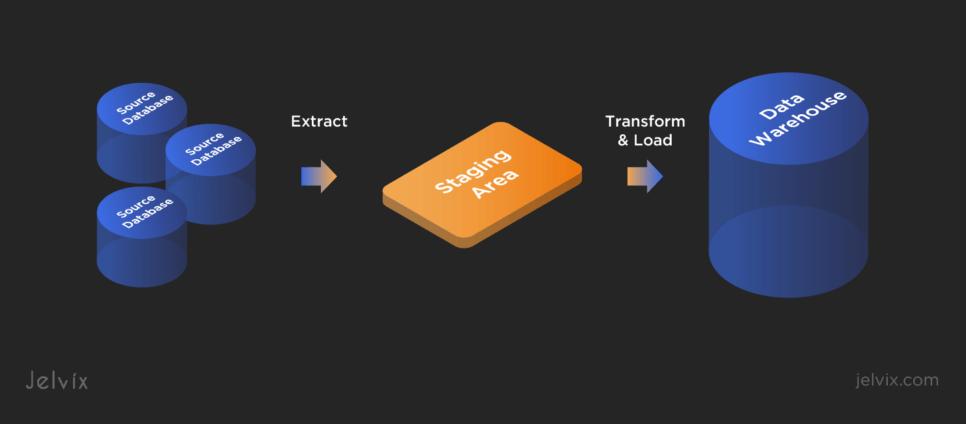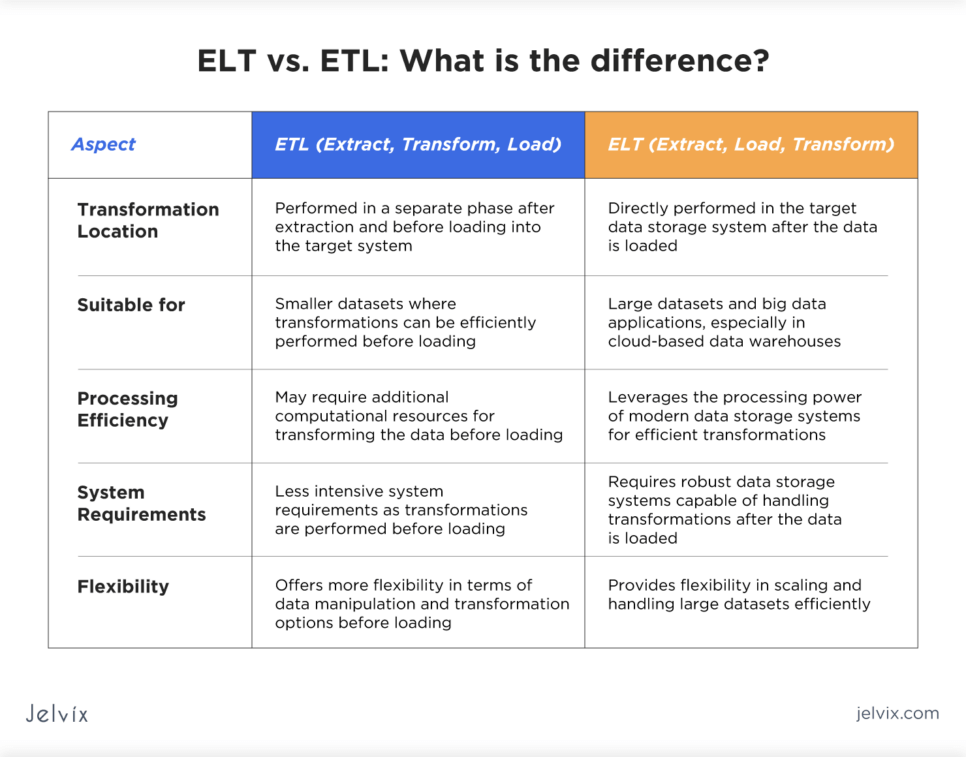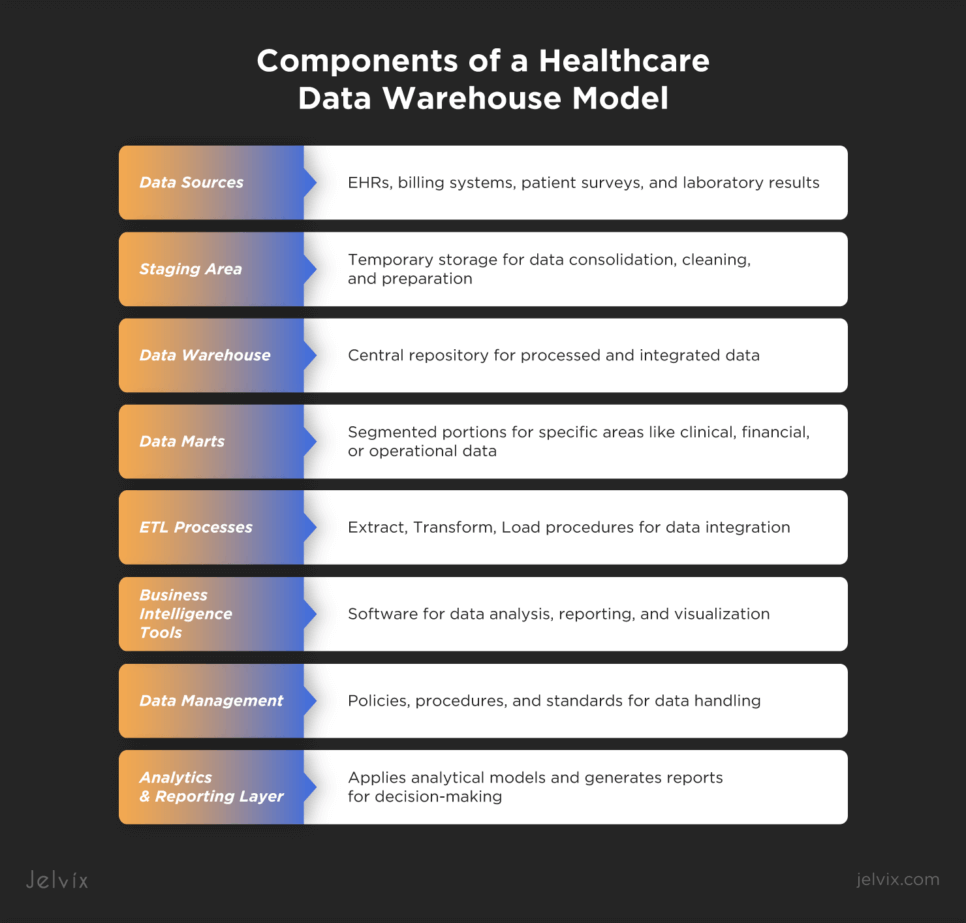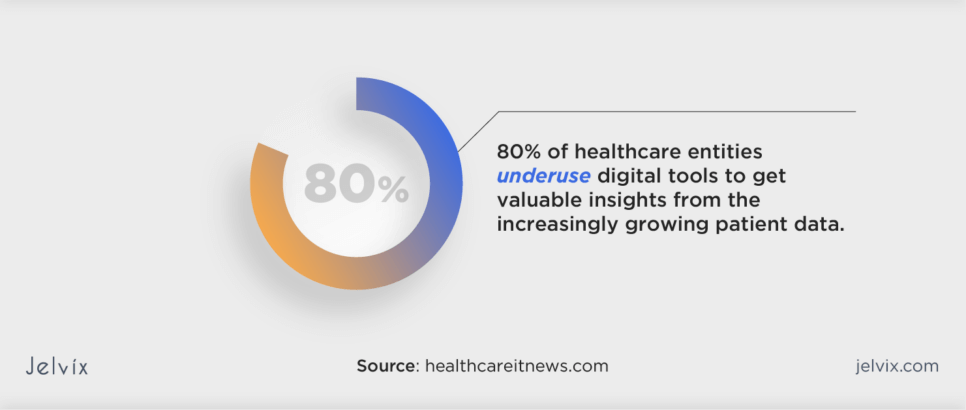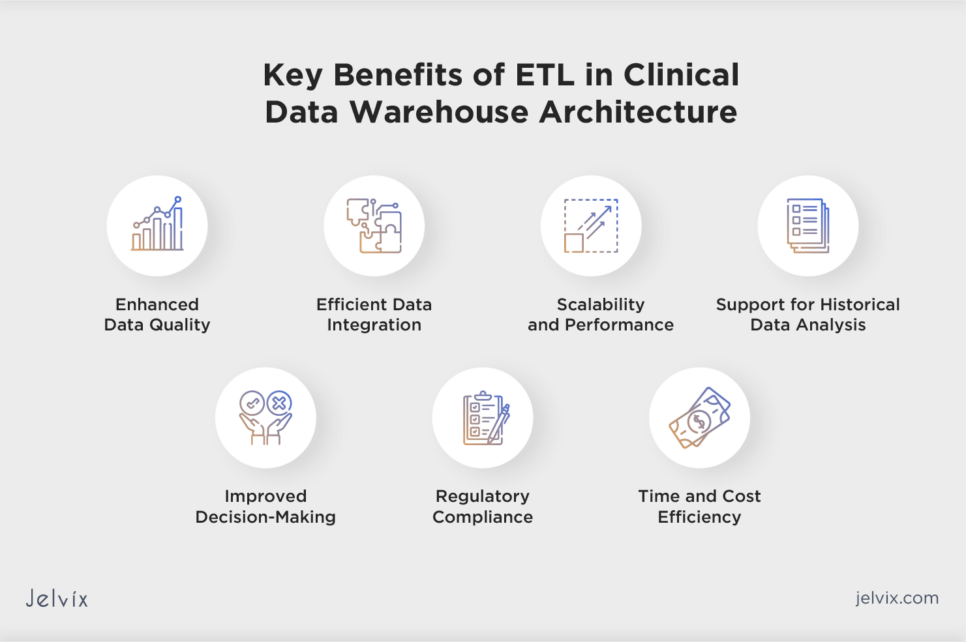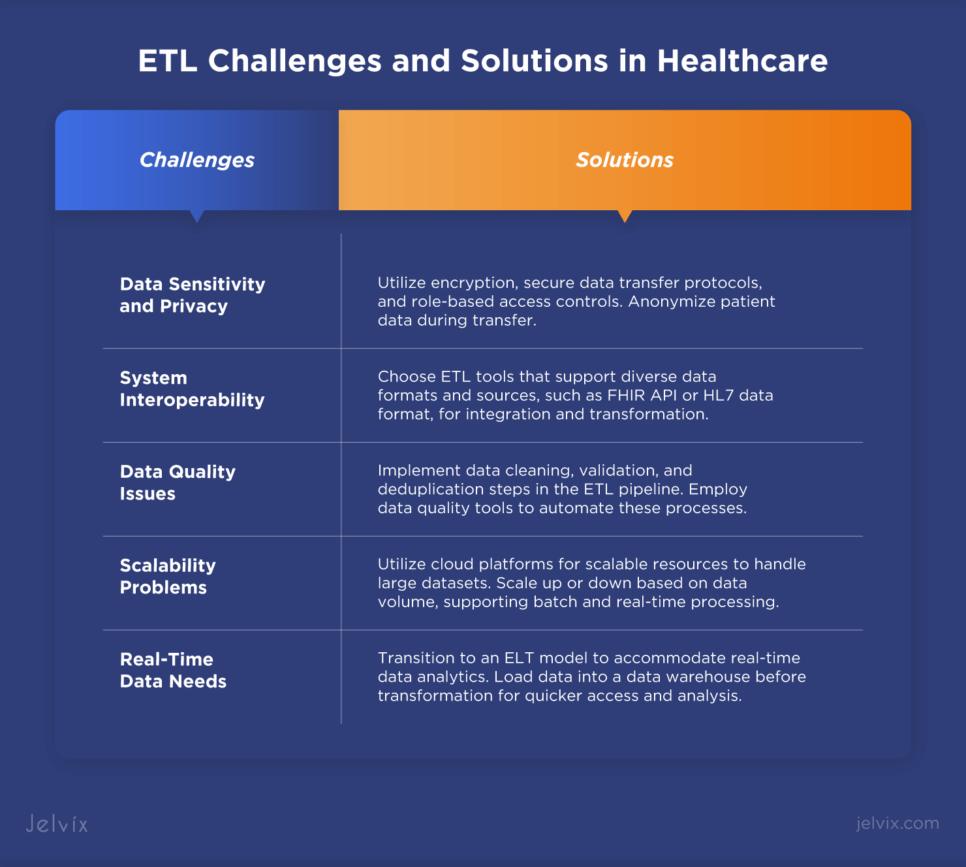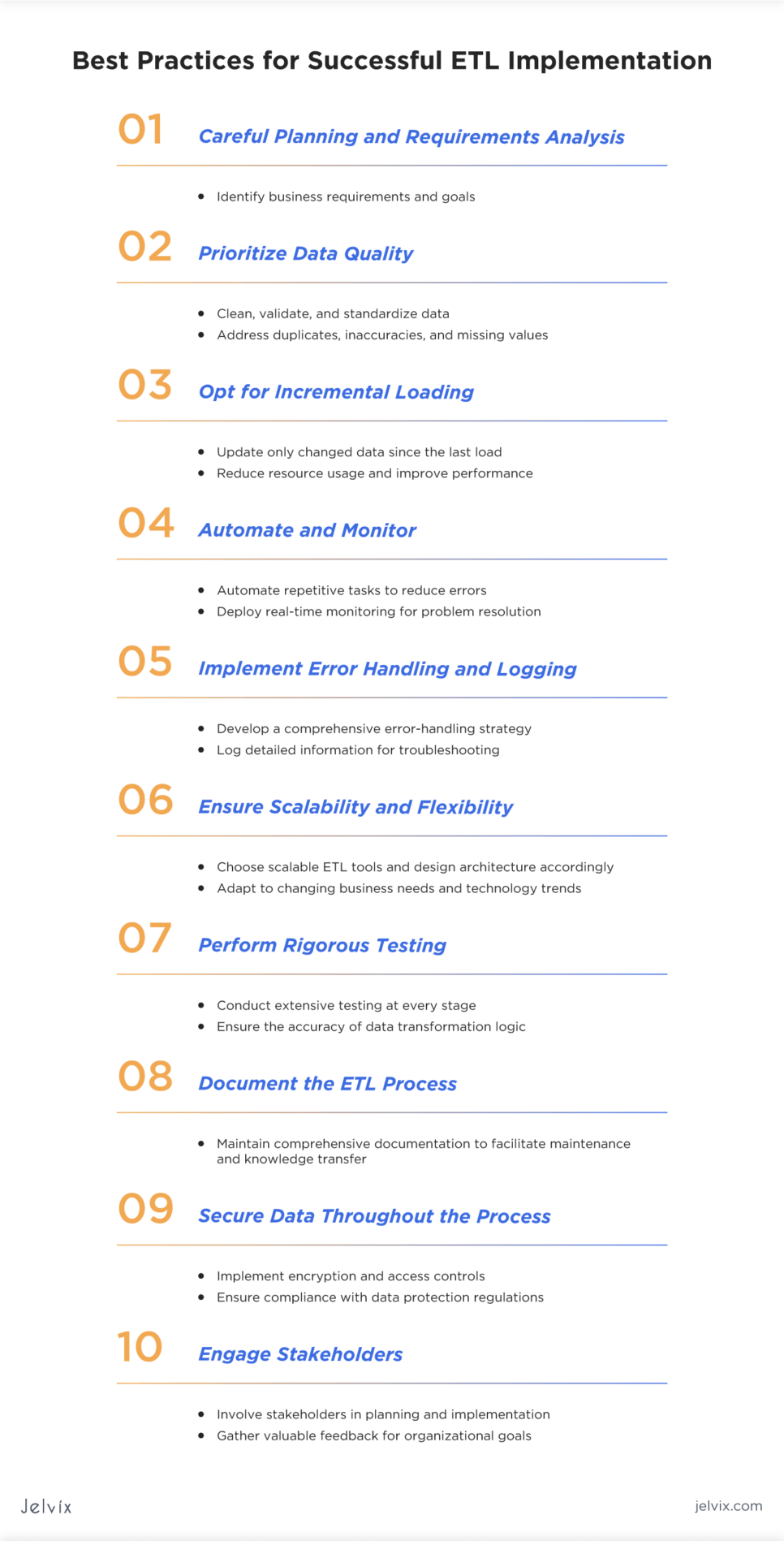The healthcare industry generates a massive amount of data daily, from patient records to insurance claims and beyond. The amount is so huge that the compound annual growth rate of medical data is about to hit 36% already in 2025, surpassing other sectors.
To use all this data effectively, clinics can rely on the Extract, Transform, Load (ETL) processes that assist in integrating disparate data sources, ensuring data quality and operational efficiency. However, the ETL process possesses unique challenges, including the complexity of cleaning data from duplicates and removing inaccuracies.
If you seek digital solutions that can support ETL processes in your healthcare settings and ensure the high quality of data along the way, read this article. You’ll explore how to handle the challenges ETL presents and discover best practices for its successful implementation.
General Overview of ETL Design in Healthcare
ETL process is extremely helpful in healthcare data management, as it enables medical companies to consolidate data from various sources into a unified format for analysis and reporting. ETL enables medical businesses and institutions to use their data’s full potential, supporting strategic initiatives and operational efficiencies.
ETL Pipeline: Main Stages
The ETL pipeline in healthcare plays an important role in consolidating, cleaning, and making data usable for analytics, reporting, and improving patient care. It is divided into three ETL process steps vital for comprehensive data management in healthcare.
1. Extract
The extraction phase involves pulling data from various healthcare information systems such as electronic health records, laboratory information systems, billing systems, and patient portals. Because of the sensitive nature of healthcare data, this stage must ensure compliance with privacy regulations like HIPAA in the U.S. and GDPR in the EU to secure data during extraction and transfer.
2. Transform
In the transformation phase, the extracted data undergoes cleaning, normalization, deduplication, and other modifications to ensure it is accurate, consistent, and formatted correctly for analysis. This step is required to address the challenges posed by disparate data sources and formats in healthcare, such as different coding standards (ICD, CPT codes) and unstructured data in clinical notes.
3. Load
During the final stage, the cleaned and transformed data is loaded into a data warehouse in a cloud or another centralized repository, where it’s structured in a way that supports efficient analysis. This consolidated data environment enables healthcare organizations to perform comprehensive analytics to drive decision-making and strategic planning.
ETL vs. ELT
ETL and ELT (Extract, Load, Transform) are two processes used for data integration and preparation, but they differ in the way data is processed and stored.
While ETL is a traditional process, ELT represents a newer approach that flips the last two stages of the ETL process. It means that data is extracted from the sources and directly loaded into the target data storage system where the transformation then happens. This method improves the processing power of modern data storage systems, allowing for transformations to be performed on large datasets more efficiently. ELT is well-suited for big data applications and cloud-based data warehouses that can handle the intensive system demands of transforming data after it’s loaded.
Choosing between ETL and ELT depends on factors like the amount of data, the computational capabilities of the data storage system, and the specific data processing needs of your organization. Each approach has its advantages and can be the best choice under different circumstances.
Key Components of Healthcare Data Warehouse Model
In the healthcare industry, data warehouses play an important role in consolidating, managing, and analyzing vast amounts of data from various sources. You need a well-structured data warehouse model to gain insights into patient care, operational efficiency, and decision-making processes.
The components of a typical data warehouse model in healthcare include:
- Data sources: these are the origin points from which raw healthcare data is collected, such as EHRs, billing systems, patient surveys, and laboratory results;
- Staging area: a temporary storage space where data is consolidated, cleaned, and prepared for integration into the warehouse. It acts as a buffer to ensure data quality and consistency;
- Data warehouse: the central repository where processed and integrated data is stored. It is structured in a way that supports efficient query and analysis, making it easier for healthcare teams to access and use the data;
- Data marts: segmented portions of the data warehouse related to specific areas of healthcare, such as clinical, financial, or operational data. Data marts allow for focused analysis relevant to particular user groups or departments;
- ETL processes: the set of procedures used to extract data from source systems, transform it into a consistent format, and load it into the data warehouse;
- Business intelligence tools: software applications that enable the analysis of data stored in the warehouse. These tools provide reporting, visualization, and dashboard features to help interpret the data and derive actionable insights;
- Data management: the policies, procedures, and standards that govern how data is handled within the warehouse. This includes measures for ensuring data quality, security, and compliance with healthcare regulations like HIPAA;
- Analytics and reporting layer: this component applies analytical models to the data and generates reports, supporting evidence-based decision-making and strategic planning in healthcare entities.
Combined, these components form the basis of a typical healthcare data warehouse model, allowing clinics to use the power of data to improve patient care, optimize operations, and make informed strategic decisions.
Applications of ETL In Healthcare
80% of healthcare entities underuse digital tools to get valuable insights from the increasingly growing patient data. The ETL process helps to manage all this data efficiently, offering a wide range of applications in healthcare.
Clinical Research Networks
ETL is important for clinical research networks, as it facilitates the aggregation and standardization of data from diverse sources, including clinical trials and patient registries. This consolidated data enables researchers to conduct comprehensive analyses, identify trends, and develop evidence-based treatments.
Data Pipelines and Analytics
Healthcare organizations can use ETL to build robust data pipelines that impact analytics platforms, supporting a wide range of analyses from population health management to operational optimization. By ensuring the data is clean, consistent, and structured, ETL enables healthcare entities to derive actionable insights, support decision-making processes, and tailor interventions to patient needs.
Explore how predictive analytics is reshaping healthcare delivery with RPM.
Real-Time Insights
ETL processes support real-time data integration and analysis, allowing physicians to gain immediate insights into patient conditions, resource use, and care delivery processes. This real-time capability facilitates urgent care, monitoring of chronic conditions, and optimizing resource allocation in dynamic healthcare environments.
Data Integration and Management
ETL is essential for integrating data scattered across various systems into a cohesive framework. It enables healthcare organizations to manage their data effectively, ensuring interoperability between different systems and facilitating a complete view of patient information.
Quality Assurance
ETL processes contribute to quality assurance in healthcare by offering data integrity and reliability. Through careful data cleaning and validation, ETL helps maintain high-quality data standards, which are vital for accurate reporting, compliance with healthcare regulations, and ongoing quality improvement initiatives.
Key Benefits of ETL in Clinical Data Warehouse Architecture
The proper integration of ETL processes in data warehouse architecture offers numerous benefits that significantly enhance data management, analysis, and decision-making capabilities within medical organizations. Through improved data quality, efficient integration, scalability, and enhanced decision-making, ETL processes can help maximize the value of data warehousing investments.
Enhanced Data Quality
ETL processes involve rigorous data cleaning and transformation procedures that can significantly improve data quality. By resolving inconsistencies, eliminating duplicates, and standardizing data formats, ETL ensures that the data stored in the warehouse is accurate, reliable, and consistent.
Efficient Data Integration
One of the most valuable benefits of ETL in data warehouse architecture is the seamless integration of data from diverse sources. ETL processes consolidate disparate data into a unified format in the data warehouse. This integration assists with comprehensive analysis that enables organizations to gain holistic insights across various operational areas.
Scalability and Performance
ETL processes are designed to efficiently handle large volumes of data, making it possible to scale data warehousing solutions as your company’s needs grow. By managing the complexity and volume of data operations, ETL ensures the warehouse remains responsive and capable of supporting advanced analytics and BI tools.
Support for Historical Data Analysis
ETL processes facilitate the storage and management of historical data within the data warehouse, providing a valuable resource for trend analysis, forecasting, and planning. This historical perspective enables medical entities to understand changes over time, evaluate long-term performance, and make predictions about future trends.
Improved Decision-Making
By providing a centralized, consistent, and high-quality data source, ETL enhances the decision-making process. As a result, decision-makers get access to reliable information, comprehensive insights, and actionable data, allowing for informed and strategic decisions that can drive organizational success.
Regulatory Compliance
ETL processes support regulatory compliance and data security by implementing data governance standards, ensuring data privacy, and maintaining data integrity throughout the whole data lifecycle. By adhering to regulatory requirements and employing secure data handling practices, healthcare companies can protect sensitive patient information from leaks and mitigate the risk of data breaches.
Time and Cost Efficiency
Although setting up ETL processes requires an initial investment, they can lead to significant time and cost savings in the future. By automating data integration and transformation tasks, ETL reduces manual labor, minimizes errors, and accelerates the availability of data for analysis.
Discover the complexities of system integration and optimize your processes for seamless operations.
ETL Challenges and Solutions in Healthcare
Although the ETL process is essential for managing the vast data crucial for patient care and operational efficiency, it comes with challenges that require strategic solutions to ensure success. Overcoming these challenges requires a careful selection of ETL tools, strategic planning, and continuous improvement of data management practices.
Data Sensitivity and Privacy
Ensuring privacy and security during ETL poses a significant challenge, as healthcare data includes sensitive patient information that requires strict compliance with laws like HIPAA and GDPR. Use encryption, secure data transfer protocols, and role-based access controls to protect data throughout the ETL process. Also, make sure to anonymize patient data during the transfer to ensure its privacy.
System Interoperability
Healthcare data comes from diverse sources in various formats, making standardization and integration complex. Use ETL tools that support diverse data formats and sources, such as FHIR API or HL7 data format, to facilitate the integration and transformation of diverse medical data.
Data Quality Issues
Inconsistent, incomplete, or incorrect data can result in critical medical errors that are believed to be the 3-rd leading cause of death in the U.S. To prevent negative care outcomes, incorporate data cleaning, validation, and deduplication steps in the ETL pipeline. Employing data quality tools can automate these processes, improving data accuracy and reliability.
Scalability Problems
The exponential growth of healthcare data demands ETL processes that can scale effectively to manage increasing data volumes. Cloud platforms offer scalable resources to handle large datasets, providing flexibility to scale up or down based on data volume, and can support batch and real-time processing.
Real-Time Data Needs
Healthcare decisions often require real-time data, challenging traditional ETL processes that are batch-oriented and may introduce delays. Switching to an ELT model can better accommodate the need for real-time data analytics. By loading data into a powerful data warehouse before transformation, healthcare organizations can access and analyze it more quickly.
ETL Best Practices for Successful Implementation
The success of an ETL implementation depends on careful preparation and planning as well as testing and data quality. To perform the implementation painlessly, the Jelvix team recommends that you follow the best practices listed below.
1. Careful Planning and Requirements Analysis
Start with a comprehensive understanding of your data sources, volume, and quality, as well as the specific business requirements and goals of the ETL process. Detailed planning helps identify potential challenges and requirements early on, enabling a smoother implementation process.
2. Prioritize Data Quality
Incorporate data cleaning, validation, and standardization before you start to enhance data quality. Addressing issues like duplicates, inaccuracies, and missing values early in the process ensures reliable data for analysis and decision-making.
3. Opt for Incremental Loading
Implement incremental data loading, where possible, instead of full loads. This approach updates only the data that has changed since the last load, reducing resource usage and improving performance, especially for large datasets.
4. Automate and Monitor
Automate repetitive and time-consuming tasks within the ETL process to reduce manual errors and improve efficiency. Implement monitoring tools to track the ETL process in real-time, allowing for quick identification and resolution of issues.
5. Implement Error Handling and Logging
Develop a comprehensive error-handling strategy to manage and resolve issues during the ETL process. Logging detailed information about the ETL operations helps in troubleshooting and auditing the data flow.
6. Ensure Scalability and Flexibility
Choose ETL tools and design the architecture with scalability in mind to accommodate future data growth and new sources. A flexible ETL process can adapt to changing business needs and technology trends without significant rework.
7. Rigorous Testing
Conduct extensive testing at every stage of the ETL process, including unit, system, and user acceptance testing. This will help ensure the accuracy of the data transformation logic and the reliability of the data load.
8. Document the ETL Process
Maintain comprehensive documentation of the ETL process, including data source mappings, transformation rules, and load strategies. Documentation will help with maintenance, future enhancements, and knowledge transfer across the healthcare teams.
9. Secure Data throughout the Process
Implement data security measures, including encryption and access controls, to protect sensitive information during the extraction, transformation, and loading phases. This will help ensure compliance with data protection regulations and data safety.
10. Engage Stakeholders
Involve stakeholders in the planning phase and keep them engaged throughout the whole ETL implementation process. Their insights can provide valuable feedback on data needs and help ensure the final solution meets organizational goals.
How Custom Solutions Can Reinforce Your ETL Processes
If your company is aimed at enhancing data management and analytics, ETL is the process you can’t ignore. With ETL, you can unlock valuable insights into patient care, operational efficiency, and financial performance, contributing to improved decision-making and enhanced patient outcomes.
If you need guidance in setting up the ETL process or building a data warehouse in your healthcare settings, get in touch with our team. With extensive experience in crafting tech solutions, including FHIR server integration and enterprise data warehouse development, we offer personalized consultations tailored to your organizational needs and future growth.
Considering a tech collaboration?
Discover our healthcare software development services with our skilled team.


